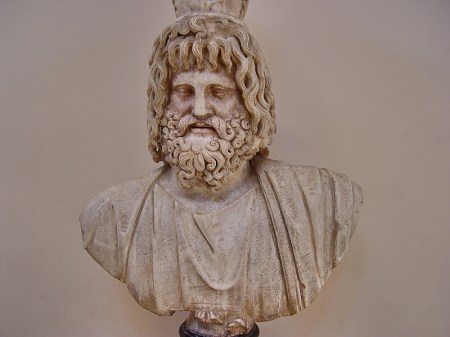I continue to be amazed at how far-flung was the influence and reach of various gods in biblical times. For example, the god Serapis, the Egyptian god of healing, was widely worshiped, and far beyond the territory of Egypt.

Egyptian god Serapis. Alexandria Museum, Alexandria, Egypt. Photo by Leon Mauldin.
Serapis was worshiped at Pergamum in biblical Asia Minor, where the ruins of his impressive temple can be seen. See our post here.
In an entry, “Idols, Meats Offered to” in the New Bible Dictionary R. P. Martin gives this info under “The Background,” and note his specific reference to Serapis (the Serapeum mentioned is a temple devoted to the worship of Serapis):
Evidence for the practice of a meal in the temple is found in the following well-known Oxyrhynchus papyrus which Lietzmann regards as ‘a striking parallel’ to the reference in 1 Cor. 10:27: ‘Chaeremon invites you to dinner at the table of the lord Serapis (the name of the deity) in the Serapeum tomorrow the 15th at the 9th hour’ (= 3 p.m.) (quoted and discussed in Chan-Hie Kim’s essay, ‘The Papyrus Invitation’, JBL 94, 1975, pp. 391–402). An invitation to a meal of this character, whether in the temple or in a private house, would be commonplace in the social life of the city of Corinth, and would pose a thorny question for the believer who was so invited. Other aspects of life in such a cosmopolitan centre would be affected by the Christian’s attitude to idol-meats. Attendance at the public festivals, which opened with pagan adoration and sacrifice, would have to be considered. Membership of a trade guild, and therefore one’s commercial standing, and public-spiritedness were also involved, as such membership would entail sitting ‘at table in an idol’s temple’ (1 Cor. 8:10). Even daily shopping in the market would present a problem to the thoughtful Christian in Corinth. As much of the meat would be passed on from the temple-officials to the meat-dealers and by them exposed for sale, the question arose: was the Christian housewife at liberty to purchase this meat which, coming from sacrificial animals which had to be free from blemish, might well be the best meat in the market? Moreover, there were gratuitous banquets in the temple precincts which were a real boon to the poor. If 1 Cor. 1:26 means that some of the Corinthian church members belonged to the poorer classes, the question of whether they were free or not to avail themselves of such meals would have been a practical issue.
This information can help clarify some of the concerns expressed in the letter of 1 Corinthians.
Consider also the situation at Thessalonica, where evidence of Serapis worship (as well as other gods) has been discovered. This would illuminate 1 Thess. 1:9 which states, “For they themselves declare concerning us what manner of entry we had to you, and how you turned to God from idols to serve the living and true God.”
The 1939 discovery of a Serapeum offers an indication of the religious life in Thessalonica (Donfried, Paul, Thessalonica and Early Christianity, 22–23). Typically, a Serapeum functions as a temple dedicated to the worship of Serapis. The discovery of Egyptian idols, including Serapis, at the site has led to its generic designation as a Serapeum. Nearly seventy inscriptions related to the worship of Egyptian gods have been discovered in the city (Witt, “The Egyptian Cults,” 324–33)—35 of which come from the Serapeum. Other finds at the location include fragmentary statues of Serapis and Isis and Roman statues of Aphrodite, Isis, and Harpocrates (Hendrix, “Thessalonica,” 523; Vickers, “Hellenistic Thessaloniki,” 164–65).
The relatively diminutive size of the Serapeum (11 meters x 8 meters), coupled with the large number of artifacts related to Egyptian deities, indicates that this building could not have been the primary temple for Serapis in Thessalonica. Two inscriptions from the site to Serapis and Osiris indicate it probably functioned as a healing shrine (Koester, “Egyptian Religion,” 134–38). The early church’s emphasis on divine healing (and exclusivity) would have conflicted with the Serapis religious groups and numerous other such groups in the city. .
The mixture of deities at the Serapeum and throughout the city illustrates the syncretic tendencies of Hellenistic Thessalonica. These tendencies did not wane with the shift to Roman rulership, and accentuate the severity of Paul’s encouragement that the Thessalonian Christians “turned to God from idols to serve the living and true God” (1 Thess. 1:9) (The Lexham Bible Dictionary).
Click on image for larger view.
0.000000
0.000000




 Posted by Leon Mauldin
Posted by Leon Mauldin 



